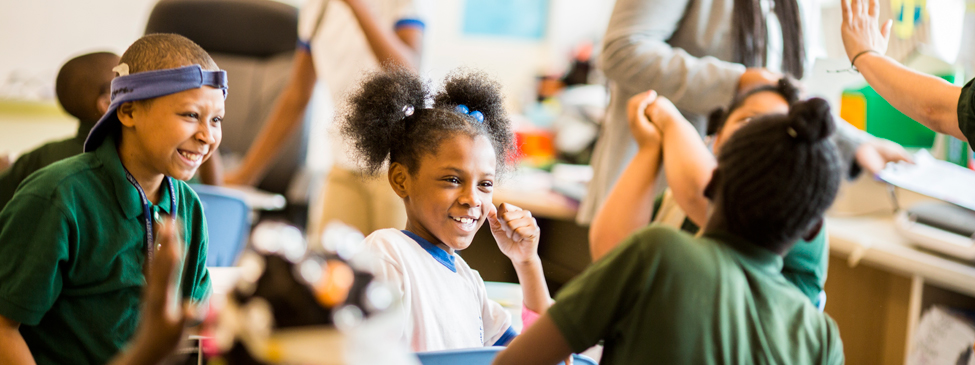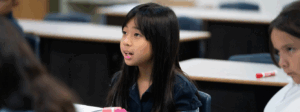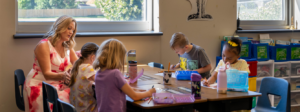Authentic community engagement—collaborating with and learning from all stakeholders, including district leaders, teachers, families, civic leaders, students, and others—is critical to student success. Over the past year, we’ve interviewed hundreds of thought leaders, teachers, professors, district leaders, and experts in education to find out what this work looks like when it’s done well. A few bright spots emerged, and District of Columbia Public Schools was one of them. Under the leadership of Josephine Bias Robinson (who reports directly to Chancellor Kaya Henderson), DCPS has positioned teachers to partner with families to advance student learning, and build partnerships with members of the community. We sat down with two members of Josephine’s team, Vincent Baxter and Shanita Burney, to learn more about their work.
Can you tell us a little bit about how DCPS approaches family and community engagement?
Vincent: There are two pieces to our approach. My work is the direct teacher and school leader strand—the work we do training educators to engage with families. For example: How do you do an effective home visit? How do you hold effective, ongoing information-sharing phone calls with families? We want parents to have genuine relationships with their children’s teachers, to share information back and forth, and really work together. Ideally, when we meet families out in the community, they say, “I love DCPS because I have a relationship with my kid's teacher.”
Getting there takes real effort. We need to recruit teachers and principals and superintendents who have the mindset that relationships matter. We also need to help teachers develop the skills to partner with families on academics, and give them the tools to share information with families. These skills have become part of the definition of highly effective teaching in DCPS.
Shanita: In parallel to this, my work is about developing ways of engaging with our stakeholders on big issues in our school district. For example, we're about to develop our budget for next school year and the public has a lot to do with that. The goal is that along with parents saying, “I've got a relationship with my child’s teacher,” they’re also saying, “I have a voice in where my school district is headed.”
There is just no way we can improve educational outcomes for students alone. Our approach to reform has shifted over the past four to five years. We are doing this work in partnership with, instead of to, parents and community stakeholders. That is a real paradigm shift.
Can you talk about that shift?
Shanita: The community’s trust in DCPS hit a real low after the 2008 school closings. Folks felt as if we were not genuine when we engaged them, that we were just trying to check a box off. That reflected in our enrollment. Communities need to feel that a district is invested in them, even if there are failing schools. We decided to focus on building relationships and trust for the next couple of years.
Vincent: Our friends at Flamboyan Foundation here in DC oriented us to research that looked at hundreds of turnaround schools over multiple years. This study found that schools that were able to sustain turnaround were certainly focused on improving rigor, improving teacher quality, attracting and retaining great leaders, and having safe and secure schools. But they were also focused on building partnerships with families. A school’s chance of sustaining positive outcomes plummets if they don't have that piece.
I’ve heard you say community engagement is really learning about what a district can gain through collaboration with stakeholders to help meet goals for students. You've also mentioned that a “feedback loop” is critical. What do you mean by that?
Shanita: One thing we’ve learned is that it isn’t enough to collect community input and leave it at that. At one point, we realized we knew how to hold a great meeting where people felt they had ample opportunity to provide meaningful feedback. But we weren’t consistently sharing back with families to let them know how things ended up, and what we used and didn’t use from their feedback. Building a feedback loop is important because, among other things, it prioritizes sharing back with the community, and it helps us make sure we're implementing an engagement effort with fidelity.
How do you assess whether family and community engagement is going well?
Shanita: Measuring how any institution is strengthening relationships with its stakeholders is tough. Many school districts struggle with it, and we do, too. But we’re excited about some systems we’ve created that are allowing us to crack this nut. For example, we prioritize who we are engaging with and how by completing a stakeholder analysis that allows us to make informed decisions about where the needs are greatest and where our efforts will have the most impact.
Vincent: The gold standard in this work is improved outcomes for kids. We know for sure that family engagement leads to improved student outcomes—it’s indisputable. A recent study found that a DCPS student who received a home visit missed an average of 24 percent fewer days of school, and had 1.55 times greater odds of reading on or above grade level at the end of the year, compared to peers who did not receive home visits.
When I visited the District recently, I asked 10 to 15 people randomly in the hallway what they do. It didn't matter their job, whether it was the security guard or an administrator, everyone described their work in relation to how it affects children.
Vincent: That’s great to hear. This summer we ran something called the Home Visit Buddy Initiative, where we invited central office staff to accompany teachers on home visits. In September, we had a debrief session where we asked, “What did you learn and how are you thinking differently about your job now?”
It's paying off. For example, the folks who create our school year calendar are now saying, “Well, we should probably think about when parents can get childcare. I hadn't thought about that before.”
One of the reasons this all works, by the way, is because it’s important to our chancellor, Kaya Henderson. She talks a lot about being “proximate to the people we serve.” The people we serve, who have kids in our schools, have the solutions to the problems they encounter. It's our job to help them get those solutions out and think through them.
What words of wisdom would you give a district that wants to engage in this work?
Vincent: Focus on what's healthy. Magnify the bright spots. Rather than saying, “This is all broken—how are we going to fix it?” look for those teachers who are doing this really well already. Whenever possible, don't have a central office person stand on stage with a microphone, saying, “You should really do these three key things.” Instead, have the teacher or the parent leader on stage to say, “This is what I do. I have the same resources that you have. These are the comparatively better results I’m getting.”
Shanita: Remember that this is transformative work. You have to be in it for the long haul because it takes time to see results. Understanding where you're trying to go, pacing yourself, and being clear about what you're trying to accomplish is really important. This can be some of the most rewarding, incredible, passionate, but also painstaking, thankless work in a given year. You've got to persevere. You have to have tenacity, otherwise this work just won't take off.








